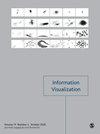屏幕响应可视化对数据理解的影响
IF 1.8
4区 计算机科学
Q3 COMPUTER SCIENCE, SOFTWARE ENGINEERING
引用次数: 4
摘要
为墙壁显示器和移动屏幕等异构设备设计的可视化界面必须对不同的显示尺寸、分辨率和交互能力做出响应。在这篇论文中,我们报告了两项关于大显示器和小显示器视觉表示的用户研究。我们实验的目的是研究大型垂直显示器和移动手持显示器在数据理解和所得见解质量方面的差异。为此,我们为大型显示器开发了一个具有协调多视图布局的视觉界面,并为移动条件开发了同一界面的两种替代设计——节省空间的边界可视化布局和概览布局。第一个实验是一项对照实验室研究,旨在评估显示器大小对视觉表现变化感知的影响,即使完成时间保持相似,也会产生显著的正确性差异。第二项评估是在实际环境中进行的定性研究,表明参与者能够轻松地将反应性可视化联系起来并进行工作。基于这些结果,我们通过为屏幕响应可视化界面提供新的指导方针来总结本文。本文章由计算机程序翻译,如有差异,请以英文原文为准。
Effects of screen-responsive visualization on data comprehension
Visualization interfaces designed for heterogeneous devices such as wall displays and mobile screens must be responsive to varying display dimensions, resolution, and interaction capabilities. In this paper, we report on two user studies of visual representations for large versus small displays. The goal of our experiments was to investigate differences between a large vertical display and a mobile hand-held display in terms of the data comprehension and the quality of resulting insights. To this end, we developed a visual interface with a coordinated multiple view layout for the large display and two alternative designs of the same interface – a space-saving boundary visualization layout and an overview layout – for the mobile condition. The first experiment was a controlled laboratory study designed to evaluate the effect of display size on the perception of changes in a visual representation, and yielded significant correctness differences even while completion time remained similar. The second evaluation was a qualitative study in a practical setting and showed that participants were able to easily associate and work with the responsive visualizations. Based on the results, we conclude the paper by providing new guidelines for screen-responsive visualization interfaces.
求助全文
通过发布文献求助,成功后即可免费获取论文全文。
去求助
来源期刊

Information Visualization
COMPUTER SCIENCE, SOFTWARE ENGINEERING-
CiteScore
5.40
自引率
0.00%
发文量
16
审稿时长
>12 weeks
期刊介绍:
Information Visualization is essential reading for researchers and practitioners of information visualization and is of interest to computer scientists and data analysts working on related specialisms. This journal is an international, peer-reviewed journal publishing articles on fundamental research and applications of information visualization. The journal acts as a dedicated forum for the theories, methodologies, techniques and evaluations of information visualization and its applications.
The journal is a core vehicle for developing a generic research agenda for the field by identifying and developing the unique and significant aspects of information visualization. Emphasis is placed on interdisciplinary material and on the close connection between theory and practice.
This journal is a member of the Committee on Publication Ethics (COPE).
 求助内容:
求助内容: 应助结果提醒方式:
应助结果提醒方式:


